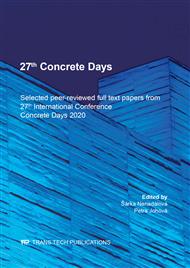[1]
Ráček, V., Vodička, J., Krátký, J. (2015). Comparison of MC 2010 and ČSN 73 2452 - steel fibre reinforced concrete classification into the strength classes [online].[cit. 2020-10-07]. https://stavba.tzb-info.cz/beton-malty-omitky/13029-srovnani-mc-2010-a-csn-73-2452-pri-zatrideni-dratkobetonu-do-pevnostni-tridy. (In Czech).
Google Scholar
[2]
Krátký, J., Trtík, K., Vodička, J.,Commentary and Examples to Steel Fibre Reinforced Concrete Structures Directive, first ed., Dr. Eduard Grégr a syn, Prague 1999. (In Czech).
Google Scholar
[3]
Dlouhý, L., Pouillon, S. (2019). Application of the design code for steel fibre reinforced concrete into finite element software. IOP Conference Series: Materials Science and Engineering. 596:012009.
DOI: 10.1088/1757-899x/596/1/012009
Google Scholar
[4]
DAfStb guidelines, 2011: DAfStb-Richtlinie Stahlfaserbeton. Deutscher Ausschuss für Stahlbeton - DAfStb, Berlin, German. (In German).
DOI: 10.1002/best.200900067
Google Scholar
[5]
Eurocode 2, Design of Concrete Structures - Part 1-1: General Rules and Rules for Buildings, CEN, EN 1992-1-1.
Google Scholar
[6]
ČSN P 73 2452: Fibre-reinforced concrete - Testing of hardened fibre-reinforced concrete. ÚNMZ, Prague. (2015).
Google Scholar
[7]
ČSN 73 1201: Design of concrete structures of buildings. ÚNM Prague, (1988).
Google Scholar
[8]
Tipka, M.; Vašková, J., Vodička, J. (2017): Tensile Strength Tests for Concrete and Fibre Reinforced Concrete, In: Proceedings from 24th Concrete Day 2017, Solid State Phenomena. Curich, Switzerland.
DOI: 10.4028/www.scientific.net/ssp.272.94
Google Scholar
[9]
RILEM TC 162 - TDF: Test and Design Methods for Steel Fibre Reinforced Concrete, Material and Structures, (2003).
DOI: 10.1617/13628
Google Scholar
[10]
fib – International Federation for Structural Concrete: fib - Model Code for Concrete Structures 2010, Ernst & Sohn,. Berlin, (2013).
DOI: 10.1002/9783433604090
Google Scholar
[11]
Hulett, T. & Clarke, J.. (2003). Technical report 34 (third edition) - Concrete industrial ground floors: A guide to design and construction.
Google Scholar
[12]
ČSN EN 14889 - 1 Fibres for concrete - Part 1: Steel fibres - Definitions, specifications and conformity. ČNI. (2007).
DOI: 10.3403/30110332
Google Scholar
[13]
ČSN EN 14889 – 2 Fibres for concrete - Part 2: Polymer fibres - Definitions, specifications and conformity. ČNI. (2007).
DOI: 10.3403/30110335
Google Scholar
[14]
ČSN P 73 2450 Fibre-reinforced concrete - Specification, performance, production and conformity. ČNI. (2015).
Google Scholar
[15]
ČSN P 73 2451 Fibre-reinforced concrete - Testing of fresh fibre-reinforced concrete. ČNI. (2015).
Google Scholar
[16]
ČSN P 73 2452 Fibre-reinforced concrete - Testing of hardened fibre-reinforced concrete. ČNI. (2015).
Google Scholar


